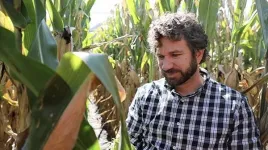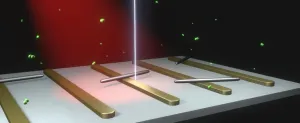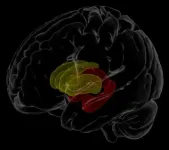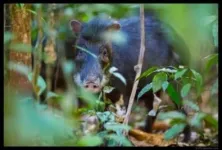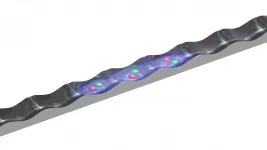Glass frogs living near roaring waterfalls wave hello to attract mates
UC Berkeley conservationist discovers the first evidence of visual communication among tropical glass frogs
2021-01-15
(Press-News.org) Berkeley -- Most frogs emit a characteristic croak to attract the attention of a potential mate. But a few frog species that call near loud streams -- where the noise may obscure those crucial love songs -- add to their calls by visually showing off with the flap of a hand, a wave of a foot or a bob of the head. Frogs who "dance" near rushing streams have been documented in the rainforests of India, Borneo, Brazil and, now, Ecuador.
Conservation ecologist Rebecca Brunner, a Ph.D. candidate at the University of California, Berkeley, has discovered that the glass frog Sachatamia orejuela can be added to the list of species that make use of visual cues in response to their acoustic environments. This is the first time a member of the glass frog family (Centrolenidae) has been observed using visual communication in this manner.
"A handful of other frog species around the world use visual signaling, in addition to high-pitched calls, to communicate in really loud environments," Brunner said. "What's interesting is that these species are not closely related to each other, which means that these behaviors likely evolved independently, but in response to similar environments -- a concept called convergent evolution."
Sachatamia orejuela glass frogs are native to the rainforests of Ecuador and Colombia. They are especially unique because they are almost exclusively found on rocks and boulders within the spray zones of waterfalls, where rushing water and slippery surfaces offer some protection against predators, and their green-gray color and semi-transparent skin make them nearly impossible to spot. As a result, little is known about this species' mating and breeding behavior.
Brunner, who studies the bioacoustics of different ecological environments, was chest-deep in an Ecuadorean rainforest stream recording the call of a Sachatamia orejuela when she first observed this visual signaling behavior. As soon as she saw the frog repeatedly raising its front and back legs, Brunner climbed a slippery rock face and balanced on one foot to get video footage of the behavior.
"I was already over the moon because I had finally found a calling male after months of searching. Before our publication, there was no official record of this species' call, and basic information like that is really important for conservation," Brunner said. "But then I saw it start doing these little waves, and I knew that I was observing something even more special."
While she filmed, the frog continued to wave its hands and feet and bob its head. She also observed another male Sachatamia orejuela glassfrog a few meters away performing the same actions.
"This is a really exhilarating discovery because it's a perfect example of how an environment's soundscape can influence the species that live there. We've found that Sachatamia orejuela has an extremely high-pitched call, which helps it communicate above the lower-pitched white noise of waterfalls. And then to discover that it also waves its hands and feet to increase its chances of being noticed -- that's a behavior I've always loved reading about in textbooks, so it is beyond thrilling to be able to share another amazing example with the world," said Brunner.
Though the COVID-19 pandemic has put a pause on Brunner's fieldwork, she hopes to return to Ecuador soon to continue her research, which links bioacoustics and conservation.
"One of the best things about fieldwork is that nature is always full of surprises -- you never know what discoveries you may happen upon," Brunner said. "I hope our findings can serve as a reminder that we share this planet with incredible biodiversity. Conserving ecosystems that support species like Sachatamia orejuela is important not only for our well-being, but also for our sense of wonder."
INFORMATION:
Juan M. Guayasamin, professor of biology at Universidad San Francisco de Quito, is a co-author of this research, which appears in the journal Behaviour. Brunner's fieldwork was supported by a National Geographic Explorer Grant (EC-57058R-19) and a National Science Foundation Graduate Research Fellowship.
Youtube video: https://www.youtube.com/watch?v=U6prmVIyxXI&feature=emb_title
ELSE PRESS RELEASES FROM THIS DATE:
2021-01-15
Plant pathologists working at universities across 26 corn-producing states in the United States and in Ontario, Canada, compiled data about annual corn reductions caused by diseases. Estimated loss from each disease varied greatly by region.
"This group of plant pathologists takes a step back to estimate what has gone wrong in corn fields in each of their states," said Iowa State University plant pathologist Daren Mueller, who was involved in this project. "Collectively, and across years, corn disease loss estimates provide folks a zoomed out view of what diseases are affecting corn in the U.S. and Canada."
To Mueller, these data represent one of the pieces of a good research project. Researchers can use these data to justify new research projects that can help mitigate the impacts ...
2021-01-15
The U.S. fishing and seafood sector generated more than $200 billion in annual sales and supported 1.7 million jobs in recent years. It experienced broad declines in 2020 as a result of the COVID-19 public health crisis, according to a new NOAA Fisheries analysis released today. While losses vary by sector, by region and by industry, data and information from this report may help businesses and communities assess losses and inform long-term recovery and resilience strategies.
According to analysts, COVID-19 protective measures instituted in March across the United States and globe contributed to an almost-immediate impact on seafood sector sales. There was a strong start to the year, with ...
2021-01-15
Like a person breaking up a cat fight, the role of catalysts in a chemical reaction is to hurry up the process - and come out of it intact. And, just as not every house in a neighborhood has someone willing to intervene in such a battle, not every part of a catalyst participates in the reaction. But what if one could convince the unengaged parts of a catalyst to get involved? Chemical reactions could occur faster or more efficiently.
Stanford University material scientists led by Jennifer Dionne have done just that by using light and advanced fabrication and characterization techniques to endow catalysts with new abilities.
In a proof-of-concept experiment, rods of palladium that were approximately 1/200th the width of a human hair served as catalysts. ...
2021-01-15
COLUMBIA, Mo. - When he was in middle school, teachers would give Sam Curran a list of words to type in a computer to practice his vocabulary. But Sam, who has autism, was unable to stay focused on the task and required a significant amount of one-to-one direction from a teacher to complete his work. After his mother, Alicia, persuaded his teachers to allow Sam to change the colors of the words, he was able to complete work more independently and began making remarkable progress.
Now 20 years old, Sam's mother continues to ensure his special interests are leveraged in an effort to continue to help him grow and develop. A new survey from the MU Thompson Center for Autism and Neurodevelopmental Disorders has found that similar strategies for children with disabilities can help reduce anxiety ...
2021-01-15
A new Northwestern University-led study is unfolding the mystery of how RNA molecules fold themselves to fit inside cells and perform specific functions. The findings could potentially break down a barrier to understanding and developing treatments for RNA-related diseases, including spinal muscular atrophy and perhaps even the novel coronavirus.
"RNA folding is a dynamic process that is fundamental for life," said Northwestern's Julius B. Lucks, who led the study. "RNA is a really important piece of diagnostic and therapeutic design. The more we know about RNA folding and complexities, the better we can design treatments."
Using data from RNA-folding experiments, the researchers generated the first-ever data-driven movies of how RNA folds as it is made by cellular ...
2021-01-15
Nearly 38 million people around the world are living with HIV, which, with access to treatment, has become a lifelong chronic condition. Understanding how infection changes the brain, especially in the context of aging, is increasingly important for improving both treatment and quality of life.
In January, researchers at the Mark and Mary Stevens Neuroimaging and Informatics Institute (USC Stevens INI), part of the Keck School of Medicine of USC, and other international NeuroHIV researchers, published one of the largest-ever neuroimaging studies of HIV. The researchers pooled magnetic resonance imaging (MRI) data from 1,203 HIV-positive individuals across Africa, ...
2021-01-15
The White-lipped peccary Tayassu pecari is a boar-like hoofed mammal found throughout Central and South America. These animals roam the forest in bands of 50 to 100 individuals, eating a wide variety of foods. In Brazil's Atlantic Rainforest, they prefer the fruit of the jussara palm Euterpe edulis.
The jussara is very abundant in this biome, probably thanks to vast amounts of dung, urine, and soil trampling by peccaries as well as tapirs (Tapirus terrestris) and other fruit-eating animals, or frugivores. This behavior releases forms of nitrogen, a key element in plant growth.
A study supported ...
2021-01-15
Boston - A national group of pediatric addiction medicine experts have released newly-established principles of care for young adults with substance use disorder. Led by the Grayken Center for Addiction at Boston Medical Center, the collection of peer-reviewed papers was developed to guide providers on how to treat young adults with substance use disorder given their age-specific needs, as well as elevate national discussions on addressing these challenges more systematically.
Published in Pediatrics, the 11-paper supplement is the result of a convening of national experts in the treatment of young adults to determine the most important principles to address when caring for this unique population of patients with substance use disorder. ...
2021-01-15
Liquids are ubiquitous in Nature: from the water that we consume daily to superfluid helium which is a quantum liquid appearing at temperatures as low as only a few degrees above the absolute zero. A common feature of these vastly different liquids is being self-bound in free space in the form of droplets. Understanding from a microscopic perspective how a liquid is formed by adding particles one by one is a significant challenge.
Recently, a new type of quantum droplets has been experimentally observed in ultracold atomic systems. These ones ...
2021-01-15
Researchers from Skoltech and the University of Texas Medical Branch (US) have shown how optoacoustics can be used for monitoring skin water content, a technique which is promising for medical applications such as tissue trauma management and in cosmetology. The paper outlining these results was published in the Journal of Biophotonics.
(swelling caused by fluid accumulation) or dehydration, which can also have cosmetic impacts. Right now, electrical, mechanical and spectroscopic methods can be used to monitor water content in tissues, but there is no accurate and noninvasive technique that would also provide a high resolution and significant probing depth required for potential clinical applications.
Sergei Perkov of the Skoltech Center for Photonics ...
LAST 30 PRESS RELEASES:
[Press-News.org] Glass frogs living near roaring waterfalls wave hello to attract mates
UC Berkeley conservationist discovers the first evidence of visual communication among tropical glass frogs
